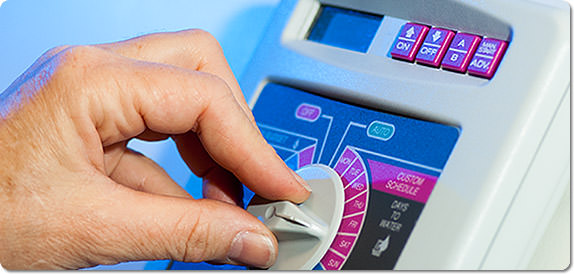
An Irrigation Timer can be the brains of your Exterior Landscape. Whether you are a residential property or a commercial property with 50 stations. An Irrigation timer is what controls the watering functions for all valves connected to the timer. An Irrigation timer has many different options and settings available. Irrigation clocks range from a 4 station (residential) clock to commercial clocks that can control up to 48 stations on one clock!
Understanding the functions available on your clock gives you the greatest advantage to having a healthy exterior landscape. Whether you irrigation is pop ups to rotors to drip system, understanding each valve and each station will allow you to program your irrigation properly and have a landscape that is as automatic as possible.
Setting up an irrigation clock:
- Depending on the size of your irrigation clock, each irrigation clock has a max number of zones that it can control. A 4 station irrigation clock can control up to 4 individual stations. Whereas a 6 Station clock can control up to 6 individual stations. Depending on the number of stations you have will determine the size of the clock that you would need to purchase.
- Each station will have to be wired directly to the irrigation clock. Each irrigation valve has 2 wires coming off of the solenoid. 1 wire is for the common and the second wire is for the actual station. When dealing with a standard wall mounted timer, it does not matter which wire off of the solenoid goes to the common and which is connected to the actual station as long as each wire is connected securely to the other.
- The common wire that is ran from the irrigation clock to the valves is typically white, this is not mandatory and can be any color you choose however it is typically a unwritten rule that the common wire is always white with the other colors available being the station wires. You will notice on smaller clocks there will be enough colors for each station. When you graduate to commercial clocks that have 24 and higher stations there typically is not enough wire colors to go around and sometimes become reused or strips are added in order to differentiate the wires. However for a residential clock you will have sufficient colors and each station will receive its own colors.
- In setting up my irrigation clock I personally have 2 rules that I always go by. I like to have all my pop ups and drip systems together as well as I like to go around the property in a circle. I will set up all my pop ups/rotors zones first. Starting at the closest zone towards me being zone #1 and continuing around the property until all pop up/rotor zones are complete. I then will switch over to my drip system zones again starting close to me and then working around the property. This is a personal preference and can be arranged to your liking. Some like to group the front/backyard together. Any way is find as long as you know which zone is what and that all zones are installed on the timer.
- Now that the irrigation clock has all the zones connected, it is time to set up the clock. Making sure that the date and time is properly set. Setting up the days of the week that you would like to water. Setting up the times of the day when water would be scheduled and finally, setting up each station to water for the proper duration.
- Be sure to check your local watering restrictions, depending on your county/city you might only be allowed to water on certain days of the week and between certain times. Making sure you follow these ordinances is very important so that you do not get fined for improper watering.
- Some county/city ordinances do not have a limit on drip watering on requiring you to water between certain times but unlimited days. The reason that I set up my timers to have pop ups first and then drip second is because for counties that have this rule all my drip system zones are together and it is very simple to add them into another program (Program B) to have watering take place every day instead of trying to remember which zone was drip for the front and which zone was drip for the back.
These are a couple tips in installing your irrigation clock for your property!


Recent Comments